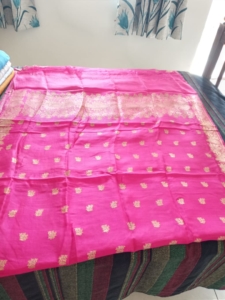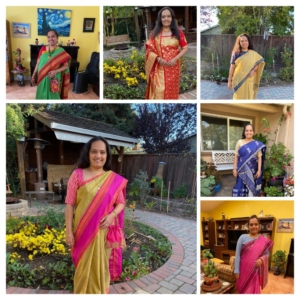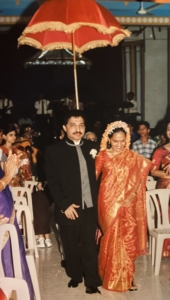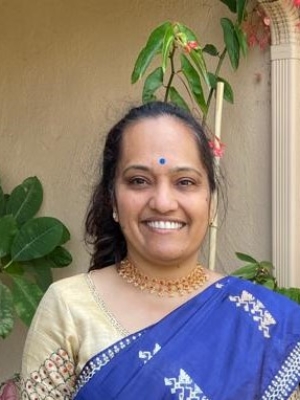Sarees in America
- “No one wears sarees in America,” my husband who was on an H1 visa in the United States said when I asked him what clothes I should bring. It was 1999, I was newly married when I said goodbye to everything that was familiar in India, and packed twenty-three years of memories into two compact suitcases, not knowing when I would return. I had an H4 visa and was not yet eligible to work. I hoped it would not be a long wait. My husband assured me I would be eligible to work (someday) and so I packed suits and trousers for “someday”, and a few sarees. Packed with care and wrapped in soft cloth, one of them was my sado (wedding saree), of a deep red hue, like Merlot that shimmered when the light bounced off the brocade. A saree expert can tell from a distance what kind of weave it is, from the sheen, the fall of the fabric, and the design on the border. Sarees are not the national dress of India. Each state has her own costume. There are more than 60 kinds of saree weaves, which have a GI (geographical indicator) tag. Like a fine wine, the name of the weave is determined by the source of the material and the location it’s woven in.
I wore my sado for my first Christmas in California. By Easter, my pregnancy had some practical wardrobe implications. I couldn’t wear my couture western trousseau, so I relied on the free-flowing saree for my baby shower. I hoped that I would have my EAD (Employment Authorization Document) and a job by the following year. Then I would treat myself to a new wardrobe. In the meantime I wrapped myself in the goodness of these six yards (the length of three dining tables seating twenty) of uncut woven fabric.
I missed my mother, who would’ve helped tuck, fold, pull, and pin the saree in the right places, but I managed with some cliffhanger mental notes.
Prerequisites: Wear a tight skirt and a blouse.
- Wrap it around your waist and tuck it into the skirt band.
- Fold and tuck in a few pleats into the skirt, around the navel. Husband to pull the fabric so the skirt doesn’t show, arrange the pleats at the bottom, and iron it out with his hand.
- Wrap it around your waist again (no tucking this time).
- Throw the remainder of the fabric across your chest and over your left shoulder. Husband to gather the pleats and pin it onto the blouse.
I got my EAD and a job, did the work life balance thing, picnicked on the lawn when my kids played soccer, threw Thanksgiving and Fourth of July parties. Although I had occasions to wear sarees, a practical constraint precluded it – that of the ill-fitting saree blouse. My blouses that were sewn in India fit a lighter version of me. So I bundled my sarees and moved them to shelves higher and higher up in my wardrobe and, settled into the seasonal fashions of Macy’s, Mervyn’s and Kohl’s.
The saree blouse was a constricting western contribution to the Indian costume, an influence of colonization meant to protect the moral character of the Indian society by introducing petticoats and saree blouses. These restricting forces of modesty were not solely a contraption of the West; it was preceded by the Indian caste system, which determined your privilege to bare or cover your breasts. Glad that we have moved away from the shackled times where men and women were forced to bare their breasts as a mark of respect to upper castes, and a breast tax was levied if they flouted the rule.
Colonization annihilated a special saree weave – the Dhaka Muslin Jamdani, by taking control over the trade and introducing policies that contributed to famines. The Dhaka Muslin Jamdani, was a fabric so renowned, that it found patrons in the likes of Marie Antoinette, Josephine Bonaparte and Jane Austen. It was so transparent that Aurangzeb scolded his daughter for appearing naked when she was draped in seven layers. It’s so soft that the western customers believed it was woven by fairies and ghosts, so light that you could fit a piece of sixty feet into a pocket snuff box. There was a time when a yard of Dhaka muslin fetched prices ranging from £50-400 ($65-525), equivalent to roughly £7,000-56,000 ($9K-73K) today. Fortunately, there are sarees for every budget and aesthetic.
I grew up in a newly independent India, where readymade clothes were ill-fitting, garish, and expensive, while locally tailored clothing was economical and stylish. Our patient tailor spent long hours deciphering the hand drawn designs my mother made from magazine cutouts or borrowed outfits – a sleeve from here, a collar from there, a neck like the one worn in that movie worn by this actress. Tailors accepted every order, negotiated every heathen design, and accepted any request for unreasonable finish times. There were too many clients in our town and not nearly enough tailors.
My tailor was a man of few words. He would simply say, with a patient smile, as if he were a physician who had just prescribed medicine, “Come back in three days.” Once, while waiting in line for my order, the woman in front of me asked about the blouses she’d ordered. She had placed her order before going on maternity leave, and she was due back at work. She had lost her patience with the tailor and loudly threatened to go to work without a blouse if he didn’t get hers done in three days time.
My shopping experience in the Bay Area was different, no tailors, no long waiting times for my western wardrobe. There were a few Indian shops that sold sarees and ready-made blouses, but out of allegiance to my habit of visiting my local tailor in India, I didn’t patronize them. I decided to wait for a trip to India to get those blouses sorted out. When those trips took place, it was challenging to make time to shop for saree blouses and deal with multiple visits to a tailor on top of fulfilling obligations towards my family, friends, and communities spread across different parts of India.
After a decade in California, my career became rewarding, my children kept me on my toes and I forgot about my sarees on the high shelves of my wardrobe, wrapped in cloth and camphor balls. Then my Nana died in India and I spotted a white butterfly in my garden for a whole week. I googled White butterfly. White butterflies show up when you are experiencing a deep energetic shift, allowing you to become more aware of yourself and your surroundings spiritually.
My nana’s funeral took place in India at exactly the same time we had our Sunday mass here in California. She always arrived in church more than thirty minutes before mass started. Nana and I had often walked to church together, smelling of Liril soap, Ponds cream, and Cuticura talcum powder. Her ritual was to have a short siesta after lunch, then iron her carefully chosen saree, saree blouse and skirt, and set them on the bed. She would take a bath with water from a brass cauldron heated with firewood, dress, and walk to church with my little hand in hers.
Nana and I were soul mates. We tried out recipes and watched television during the summers of my childhood. When I stayed up late into the midnight hours studying, she slept next to me so I wouldn’t be afraid of the dark. She taught me to embroider and knit. I was the best student in my school craft class because Nana helped me undo difficult knots, picked up my knitting when I had to do homework, and redid the lines of knitting I had done too tightly. I was one of the few knitting nerds who completed two sweaters instead of the mandatory one for class.

70 year old wedding sado belonging to my nana. Silk sarees are aired out once a year to prevent fraying.
Nana’s funeral was before there were Zoom and Facebook Live services. I was the only family member not present in person for her funeral. And so, just like my Nana would ready herself for mass, I chose to wear my sado, ironed it, and, along with my husband and sons, went for the Sunday mass in California.
When I walked into church dressed like a bride in a saree for my Nana’s funeral, which took place more than 10,000 miles away, I was early, just like my Nana always was. Upon seeing us dressed up, the usher approached me to request my family bring up the gifts during the offertory. My husband, always attuned to my spirit and knowing that any reference to my Nana might deeply upset me, accepted the request. My church friends and community came up to us to tell me how beautiful I looked, how special we all looked, and asked if it was my birthday, our anniversary, or an Indian festival? Their faces lit up at the thought of a joyous occasion, and I did not have the courage or the heart to tell them I was dressed for my Nana’s funeral. I smiled and hugged them back. I do not remember what the priest’s homily was about, I only remember that it soothed my grieving heart.
We dedicated a small garden in the front of our home to my nana, and planted 20 iceberg rose trees that bloom every year. My sarees went back into the closet on the high shelves and stayed there, until the beginning of the pandemic. India went into lockdown with a four-hour notice, and millions of daily wage immigrant workers were suddenly left unemployed, without a place to stay, and no transport to head back to their villages, so they started their foot journey back to their homes – a journey of several hundreds of miles.
When the world shut down in the early days, I found escape by knitting, painting, watching Zoom theatre and binging on Netflix. I tried to stay away from the dispiriting news of the world, but I couldn’t escape it. The lockdown got stark and grim as, the fires raged on in California. The birds vanished. The neighbor’s cats remained indoors. Election politics showed its ugly face on social media. Many businesses and artisans who relied on an in-person sale model were put out of work, many having no online presence or savviness. Whatsapp markets and collectives small and big, authentic and not, sprung up overnight to support or fleece this sector. Guilt ridden for my comparative privilege and comfort and weighed down by the collective trauma of the universe, I counted the blooms and buds in the white garden, watched the colorful butterflies and wondered what Nana would say.

Saree weave names from left to right: Gadwal , Benarasi, Ponduru Khadi, Kanjeevaram, Paat Silk Mekhela Chador and Devendra
I decided to dress up for work to keep my spirits up. I wore makeup, jewelry, and on days I felt worse, I even wore dress shoes to my Zoom meetings, my heels klicking and klacking on the wood floors. My husband helped me bring the bundle of sarees wrapped in soft cotton cloth down from the top shelf, and I started wearing them for work with western blouses. I decided to buy handwoven sarees and handmade crafts from weavers in India. I learned about the weavers, and that it takes them anywhere from one day to a few months to weave a saree. I wore them to the backyard to celebrate that I was alive.
I draped myself in weaves and designs influenced by the diversity of India’s people and its culture – the beautiful Phulkari embroidery from Punjab, Himroo silk influenced by the Mughals, Gara from the Persians, Convent embroidery made by Ursuline nuns, brocade Banarasi influenced by the Mughals and Gujaratis, and Moirang Phee from Manipur, and Dolabedi from Orissa. The Swarnachari and Baluchari from Bengal have scenes from the Ramayana and Mahabharata woven in thread and zari (red thread twisted in fine silver and dipped in gold). Temple bordered sarees, such as the Kanjeevaram from Tamil Nadu and Berhampuri from Orissa with a gopuram border, are a coveted collection. A gopuram is the entrance of a temple, which is triangular.
I wear sarees because they are my princess tiara. I wear them because they remind me of Nana, of home. They make me feel good. They remind me of the lives of the weavers, of the daily wage workers, and they remind me of my identity. If the saree, a tapestry, and an embodiment of pluralism has survived for centuries, I carry a sliver of hope for peace.
Yes, there are people who wear sarees in America.
Majella Pinto is an Indian-American writer whose work has appeared in eMerge magazine, Twist & Twain among others . She lives in Campbell, CA and is also a visual artist. Her work can be found on www.artbymajella.com.






